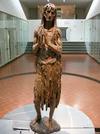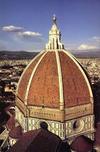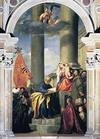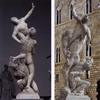Exam 3 Flashcards
(103 cards)
Who are the four evangelists and their symbols?
Matthew (man/angel) Luke (ox), Mark (lion), John (eagle)
What is horror vacui?
is the filling of the entire surface of a space or an artwork with detail.
What is Vellum?
Vellum is derived from the Latin word “vitulinum” meaning “made from calf”, leading to Old French “vélin” (“calfskin”). The term often refers to a parchment made from calf skin, as opposed to that from other animals. It is prepared for writing or printing on, to produce single pages, scrolls, codices or books.
What is Contrapposto ?
Italian term that means counterpose. It is used in the visual arts to describe a human figure standing with most of its weight on one foot so that its shoulders and arms twist off-axis from the hips and legs.
Desribe Atmospheric Perspective
Things appear to fade off into the distance. The background appears to fade off into the distance. The farther away something is the lighter the value and the bluer the color.
What is a Icon?
Icons are sacred images representing the saints, Christ, and the Virgin, as well as narrative scenes such as Christ’s Crucifixion.
What is a Basilica?
The Roman basilica was a large public building where business or legal matters could be transacted.
Where is the Aspe located in a church?
The apse is the semicircular area. Where the altar is placed or where the clergy are seated.
Where does the congregation sit?
In the Nave (or center isle)
Where are the Aisle in a basilica church?
The outskirts of the church are usualy where the Aisles are.
What is a transept? And where is it located?
A transept is an area set crosswise to the nave in a cruciform (“cross-shaped”) building in Romanesque and Gothic Christian church architecture.
What is this a picture of?

Chi Rho Iota from the Book of Kells
5th c to 1050, watercolor, tempura & vellum
Anonymous Monk
Made in Kells, Ireland
Matthews beginning page (human heads, wings, mice and cats worked into the design)
Horro Vacui
These are the same three letters of Jesus’ name in Greek
What is Repousse’
a low relief produced by hammering a metal sheet (gold) from the back to present a raised look.
What is this a picture of?

Interior view of the Chapel of Charlemagne
at Aachen (5th c - 1050)
Charlemagne is the first ruler to unify Rome. He is the first ruler to be called The Holy Roman Emporer. He accepted christianity and made it legal fro christians to practice publically again. This chapel is built into his house for all to see.
He had two heros. Emperor Constatine and Emperor Justinian
It looks alot like the St. Vitale Church in Ravenna (Justinians church)
There are archways, columns, columns in archway (stupid), Islamic colors.
What is this a picture of?

Gero Crucifx c. 970
(Early Middle Ages 5th century - 1050)
6ft wood carved, gilded oak
Commissioned by Bishop Gero for a cathedral in Cologne, Germany.
Back of the head was carved out to hold wafers. Jesus is shown suffering.
When is the Romanesque Period?
Romanesque Period - 1050-1200
What is this a picture of?
Santiago de Compostela
Romanesque Period - 1050-1200
The altar held the body of St. James. One major church along the pilgrimage route. Basilica floor plan (cross shape).
What is a Basilica floor plan vs a central plan?
Basilica Church-A rectangular hall with a gable roof, a foyer, aisle along the sides, aspe for the altar. Meant for public ceremonies.
Central Plan-cross shaped, or latin cross. It adds the transept (cross section)
Name all parts of a Central Plan church layout
Apse - semi circular where the main altar is
Transept-Cross section
Radiating chapels-small semi circles, where holy relics are placed.
Ambulatory Aisle-The Aisle that goes completely around the church. People could walk around without bothering the ceremony.
Nave-where the congregation sits.
Tympanum-Over the lintel, over the main doors, front of church, usually has a relief of some sort.
Barrel Vault construction-round arches used in construction.
Holy Relic means
Any physical body part, or items used by a holy or sacred person.
What is a Reliquary?
An object used to hold a holy or sacred relic.
What is a Tympanum?
A strucutural piece that sits over the lintel (horizontal beam) over the columns. Very popular for relief scultpures.
What is this?

San Giovanni Baptristry, Florence, Italy
Romanesque, 1060-1150c
Located in the heart of Florence, Honoring St. John the Baptist. (Patron saint of florence)
octagon, not circular
Marble, corithian columns.
No builder name
What is this?

West Facade of Cathedral of notre Dame at Chartres
1134 (Gothic 1150-1400)
badly damaged by fire, rebuilt in 1194, holds a relic of Mary (which was not burned)
Builder: Abbot Suger
Basilica shaped, exterior flying butresses added in as they went, radiating chapels. (No floor plan was ever used)
Center Door-larger (Tympanum is Christ in Majesty framed by evangelists)
Over 22k sq,ft of stained glass. Window over main door (Tree of Jess)
Mary told them to rebuild-it was renovated in Gothic style in 1134.
elongated sculptures, hanging-not on a shelf.




























































